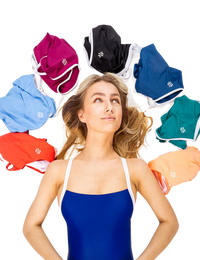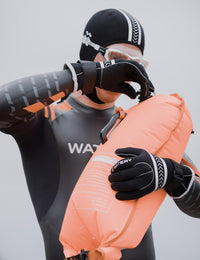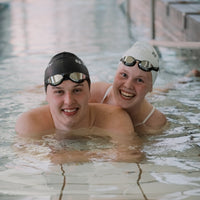Have you tried the most common forms of exercise, but never found the perfect fit for you? Running gets too boring after a while, cycling takes too much time, and you never consistently make it to the fitness centre.
It seems like swimming is what you should try! It's a different and relatively undiscovered form of exercise where you set the possibilities yourself. Almost everywhere in Ireland, there is a swimming pool that you can easily and affordably use. Swimming is also a form of exercise that, with almost 100% certainty, does not cause injuries (I haven't experienced any in 6 years with an average of 5 workouts per week). So, you can train swimming over a very long period without worrying about injuries or other things that might prevent you from swimming. This also means that swimming might be the very best form of exercise for people with back pain, bad knees, or arthritis since the joints are not stressed in the same way when it takes place in water, where the body is “weightless.”
1. Swimming quickly becomes YOUR favourite form of exercise!
There are already many people who use swimming as their weekly form of exercise, and there are several reasons for that. Whether you can swim or not, whether you're thin or thick, old or young. A regular trip to the swimming pool can mean that your muscles are strengthened, your breathing is regulated, you experience better mental relaxation and balance, and your posture and flexibility improve-all at the same time. As an added bonus, you achieve all these things without putting strain on your joints and knees, because the water supports your weight, unlike activities like jogging and running.
Moreover, there is another significant advantage. Swimming also strengthens your circulation and heart. By regularly engaging in swimming training, you simultaneously prevent the possibility of developing cardiovascular diseases. Swimming, in particular, is effective for prevention because you can easily elevate your heart rate. Remember, for example, the swimming lessons from elementary school? You could get really breathless after just a few laps. And that's not bad; on the contrary, it's excellent for the heart and your overall circulatory system.
2. It costs a blade of grass to get started
As a swimmer, you need almost nothing. With a pair of swim trunks/swimsuit and a pair of goggles, you're well on your way.
Swim trunks and swimsuits are almost a given for a swimmer—just like running shoes are for a runner. And, similar to the running market, there are all sorts of them available in various colours, patterns, sizes, and lengths.
As a fitness swimmer, it's not particularly important which swimsuit or swim trunks you have. Still, we have conducted a test with swimsuits here (LINK) and swim trunks here (LINK) on watery.ie. They just need to fit relatively snug, not be too loose, and then they're actually perfect (PS: if you want to make it a bit more challenging and push yourself a bit, you could choose to swim with the trunks loosely hanging. It makes it a bit more challenging). And if any ladies are in doubt, you can indeed swim with a bikini if you prefer. It's no problem. Such a pair of swim trunks or swimsuits usually cost no more than 40 EUR.
Additionally, I would recommend getting a pair of swim goggles. They are not necessary like swim trunks/swimsuits, but I personally find it downright uncomfortable to swim without them. Even if you plan to swim with your head above water. It's just really annoying to occasionally get splashed in the eyes—it almost makes you feel compelled to stop and “dry” your eyes. Therefore, I really think you should get a pair of swim goggles. Check out our test of the best swim goggles (link).
This way, you can get started with fitness swimming for under 67 EUR. Much cheaper than many other forms of exercise.
If you want a bit more equipment or have discovered that swimming is really fun, you can also invest in a swim cap, a pair of swim fins, and a kick board.
3. You can't go wrong with swimming
I understand the uncertainty: “What do others think of my swimming style?” “Which lane should I choose, which lane suits my level?” and “How should one behave in such a lane?” These are all questions that many people ask themselves before jumping into the swimming pool, and it's entirely normal.
There are no definitive answers to such questions because everything is okay. In swimming, you can't do anything wrong. Nothing. Everyone swims different styles in different ways, and thus, there's nothing wrong with how you swim.
Another very common question is which lane to choose. Often, in swimming pools around Ireland, the lanes are filled (especially in the morning from 6:00-7:30 and the same in the afternoon) with fitness swimmers. In such cases, it's just about getting an overview of the fitness of swimmers. Who swims fast, who swims less fast. And then, you just need to find the lane that suits you best. There shouldn't be any problems then. It's not a requirement, just a good piece of advice. You can actually pick any lane. In general, it's all about considering each other so that everyone has a good swimming experience :-)

4. An extra dimension: Get free calorie burning
Let's start by debunking a myth: You don't burn fewer calories because swimming takes place in water, and you don't necessarily sweat. You do sweat; it's just not something you notice or pay attention to, strangely enough, because you're in the water ;-)
Furthermore, it's no secret that the swimming pool can often feel a bit cold at the beginning. This is because the body is around 37 degrees Celsius, while the water is only between 26-27 degrees Celsius. And when it's a bit cold, the warm pool at the other end of the swimming pool typically seems inviting. But that's when you should try to flip it around and think of the cold water as a positive thing. When the water is cold, your body has to use a lot of energy to stay warm, resulting in even more calorie burning. Oh, that's pretty clever!
However, as you get into the training, the water will automatically start to feel warmer. Just make sure to keep moving all the time. Avoid taking several minutes of breaks at each end, and be careful not to engage in too much conversation with your swimming buddy. It becomes really cold to get back into it after a lengthy pause.
5. Swimming increases your oxygen intake more than any other form of exercise
In swimming, you use almost all muscles, including major muscle groups like the thighs, back, chest, and arms. When these muscles are trained and used, they require a lot of oxygen to keep going—really a lot. When you repeatedly expose your body to this demand for oxygen, your lung and heart capacity expand, improving your overall fitness and conditioning. And this happens much faster in the water than with any other form of exercise.
For example, if you compare swimming with running, the oxygen consumption is much higher in swimming. While at rest, you use between 0.15 and 0.25 litres of oxygen per minute, in moderate running, you use about 8 times as much, while in swimming, you use up to 12 times as much oxygen. This is something I learned in school :-)
Based on this, swimming is highly effective. You get in shape very quickly and, as a result, burn a lot of calories - not bad, right?

6. Is swimming just back and forth? It's not fun, right?
Yes, typically you just swim back and forth. Continuously. For hours. Turn after turn. But it doesn't HAVE to be that way. There are plenty of opportunities to make the training a bit more varied and fun. After 8 years as a swimmer, where I've swum more laps than many others, it's still just as enjoyable. It hasn't changed. It's just about introducing some variation into the training.
For example, you can have a little competition with the person next to you. “Shall we see who gets to the other end first?” This raises your heart rate and adds some variety to the otherwise streamlined training. Another option is to use the equipment provided by the swimming pools. You can do some leg exercises with the boards placed on the edge, use a pull buoy between your legs and swim with your arms, or buy your own snorkel and swim fins.
You could also try swimming disciplines other than just freestyle or breaststroke. Try some backstroke (good advice: glance over your shoulder so you don't swim into anyone) or how about some butterfly (Good advice: try to stick to your own lane where you won't bother many, especially not the older ladies who often get a bit upset when others splash ;-) ). It adds good and fun variation to the training, which also helps strengthen all muscles. Each of the four styles uses different muscles. In breaststroke, for example, you use mostly thigh muscles, in butterfly, it's mostly chest muscles, while in backstroke and freestyle, it's the core and arms. Therefore, it's a good idea to try all four styles.
You can also swim at different paces. For example, swim two laps at a moderate pace and then one lap fast, and you could do this a few times. This really gets your heart rate up and your body working - and that's why you swim, right?
GET A DISCOUNT CODE WITH 10% OFF
The discount code can be used by all new customers on all products on the website, including the products recommended here in the article.
What are you waiting for? Get more out of your time in and on the water!
7. What if you can't swim?
If you can't swim, it's a bit challenging to use swimming as an exercise form initially. However, it's something you can certainly learn. In almost every swimming pool/swimming club, there are classes for adults who want to learn to swim. So, you'll be with other adults who also want to learn to swim, and you'll have an instructor to teach you. Super nice. Alternatively, you can use my 10-week swimming guide here, where you get programs, tips, and motivation - I promise you'll be able to swim!
But before you start, I just want to point out that it takes time to learn. Swimming is technically challenging as it involves coordinating both arms and legs. A bit more challenging than going for a run or bike ride. But it's not that difficult, either. You just have to get started, right?
This is how you really burn a lot of energy!
We've probably all seen the older grandmothers at the swimming pool. With their heads above water, they take it very calmly. They have plenty of time.
But if you don't want to spend several hours in the swimming pool, you need to step up the pace. Especially if you really want to burn a large amount of energy and, therefore, lose weight.
So, leisurely swimming, as we call it, won't cut it.
Therefore, you need to make sure to maintain high intensity and a high heart rate for an extended period. As they say: You burn just as much by swimming for 30 minutes with relatively high intensity as by 1.5 hours of leisurely swimming. So, set the pace a bit higher and push yourself. The pounds will come off.
To increase calorie burning even more, you can press a bit harder on the water with each arm stroke. The more effort you put in, the more you burn. It also really engages your muscles, which is a good thing.
Another step could be to swim a bit of butterfly stroke.
You should genuinely feel like you're sweating buckets when you leave the pool, even if you're not actually doing it. That means you've given it enough effort.

























![[FREE GIFT 2] Watery Anti-Fog Spray](http://watery.ie/cdn/shop/files/1_8ad7b1cc-6955-4108-9f1a-8001285ee86e.jpg?v=1732816343&width=200)
![[FREE GIFT 3] Watery waterproof mobile case - Storm - Black](http://watery.ie/cdn/shop/files/Designudennavn_16_7b517ddd-25a8-4cfe-8af8-91b851f3ce89.png?v=1725466521&width=200)
![[FREE GIFT 4] Watery waterproof bum bag - Talia - Blue](http://watery.ie/cdn/shop/files/WateryTaliaBumBag-Blue_1_d4bbce92-9e6b-44e3-b32c-527b0720cb62.jpg?v=1727807316&width=200)